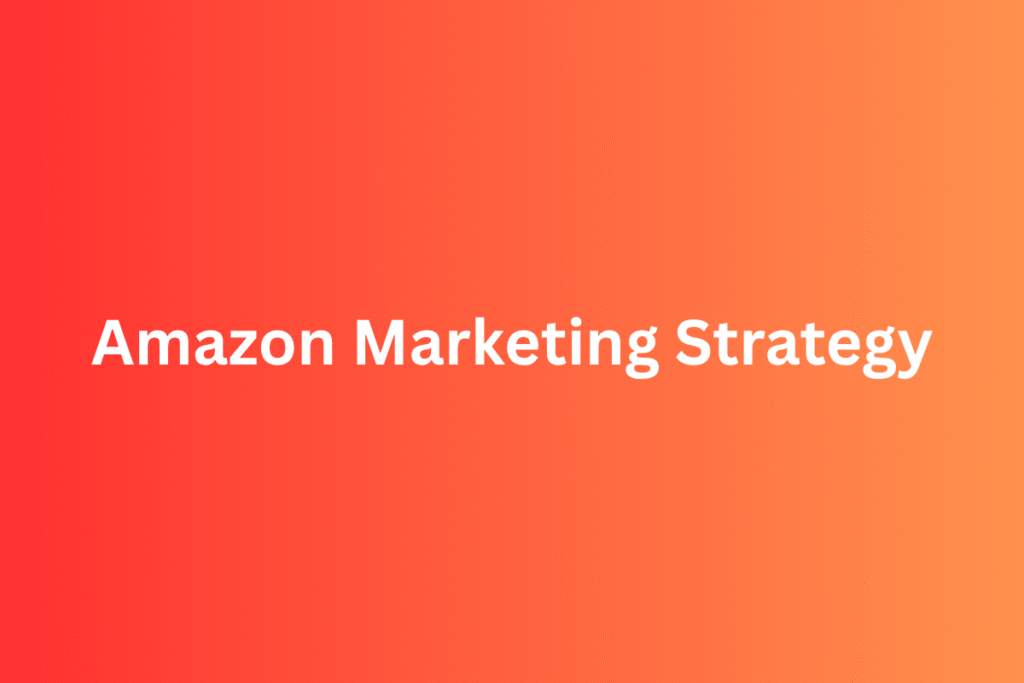When people talk about Amazon, they often focus on its massive scale, endless product selection, or same-day delivery. But what really powers Amazon’s dominance isn’t just logistics or pricing it’s a sharp, data-backed, customer-first marketing strategy.
Whether you’re a marketer, business owner, or just curious about how the world’s largest e-commerce brand keeps winning, this article breaks down Amazon’s marketing strategy in a way that’s practical and insightful with real, actionable takeaways.
1. Data-Driven Marketing: How Amazon Thinks Before It Sells
Amazon doesn’t market blindly. Every campaign, offer, and even product placement is based on real-time user data.
a) High-Runner Strategy
Instead of promoting random items, Amazon identifies products with the highest demand and pushes them through:
- Dynamic pricing: Prices are constantly adjusted to stay competitive.
- Aggressive advertising: These high-demand products are boosted through PPC campaigns across Amazon’s own platform and external channels.
This gives Amazon two key advantages quick conversions and higher ROAS (Return on Ad Spend).
b) Personalized Product Recommendations
Amazon’s recommendation engine is legendary and for good reason. It uses your:
- Purchase history
- Browsing behavior
- Abandoned carts
- Frequently viewed products
…to recommend products you’re most likely to buy. This isn’t just about upselling it’s about deep personalization that makes shopping feel effortless.
2. Digital Marketing That Goes Beyond Ads
Amazon doesn’t just rely on its platform. It uses a full-funnel, omnichannel digital marketing approach to create awareness, engagement, and conversions.
a) Social Media Marketing
While Amazon doesn’t behave like a traditional D2C brand, it uses platforms like:
- Facebook & Instagram: Product promotions, Amazon Live shopping
- YouTube: Ads + product feature content
- Pinterest: Visual discovery of niche products
These platforms help Amazon stay visible, especially during product launches or seasonal sales.
b) Influencer & Affiliate Marketing
Amazon’s Influencer Program gives creators their own storefronts to promote curated product lists. This taps into:
- Niche audiences
- Trust-based marketing
- Organic reviews that feel authentic
It’s not just about sales it’s about scaling awareness through voices people trust.
c) Email Marketing
Amazon’s email strategy is often overlooked, but it’s incredibly sharp:
- Personalized product suggestions
- Order follow-ups (e.g., “Did this product meet your expectations?”)
- Abandoned cart nudges
- Cross-sell offers
All of this is automated, segmented, and behavior-based, giving users what they want exactly when they want it.
d) Amazon Ads Platform
Amazon’s internal ad ecosystem is massive and offers:
- Sponsored Products
- Sponsored Brands
- Sponsored Display Ads
These aren’t just for Amazon’s own products. Third-party sellers and brands can plug in and leverage Amazon’s traffic for massive exposure which is why ad revenue is now one of Amazon’s fastest-growing segments.
3. Deep Customer-Centric Focus: Why People Trust Amazon
Behind every marketing move, Amazon focuses on what the customer wants not just what it wants to sell.
a) Building Accurate Buyer Personas
Amazon tracks everything: from device usage to delivery location to browsing speed. This helps build rich buyer personas, which answer:
- What does this customer care about price, quality, speed, brand?
- What time do they usually shop?
- What kind of language or offers resonate with them?
This data helps Amazon shape everything from product titles to ad copy.
b) Compelling Product Pages
Amazon product pages aren’t just SEO-optimized they’re conversion-optimized. Key features include:
- Multiple, high-quality images
- Bullet points for scannability
- Q&A section for objections
- Verified reviews for credibility
- A+ Content for brands (enhanced branding and storytelling)
This isn’t just good UX it’s strategic persuasion.
c) Seamless Customer Experience
Marketing isn’t just about promotion. For Amazon, the post-purchase experience is part of the brand:
- One-click refunds
- Hassle-free returns
- Transparent delivery tracking
- Responsive customer service
These touchpoints create loyalty, which is why people come back again and again.
4. Innovation and Market Expansion: Amazon’s Bigger Vision
Amazon isn’t just in e-commerce anymore. Its marketing strategy also involves brand-building through diversification.
a) From Books to… Everything
Amazon started with books. Now it owns:
- Prime Video (streaming)
- Amazon Music (audio)
- Amazon Fresh (groceries)
- Amazon Web Services (cloud computing)
- Amazon Style (fashion + retail experience)
Each new vertical expands Amazon’s customer base and creates cross-promotional marketing opportunities.
b) Continuous Product and Feature Innovation
Whether it’s voice shopping via Alexa, cashier-less checkouts at Amazon Go, or AI-powered product search, Amazon keeps testing new ways to make buying easier and more immersive.
The brand isn’t just selling it’s shaping how people shop in the future.
5. Retargeting and Remarketing: Amazon Never Forgets
You view a product on Amazon and suddenly see it everywhere. That’s no coincidence.
Amazon uses retargeting pixels and email triggers to bring users back, often with:
- Time-sensitive discounts
- Product bundles
- Low-stock alerts
This increases repeat visits and reduces lost sales.
6. Prime as a Marketing Tool
Amazon Prime is more than a subscription it’s a loyalty and marketing engine.
By offering:
- Free fast delivery
- Exclusive deals
- Early access to sales
- Prime-only content (videos, books, music)
…Amazon creates a closed ecosystem where customers are more likely to stay, buy more frequently, and shop only on Amazon.
What You Can Learn from Amazon’s Marketing Strategy
Amazon’s marketing isn’t just about selling more it’s about:
- Understanding customer intent
- Meeting demand before it’s spoken
- Optimizing every touchpoint from ad to delivery
- Using data not just to react, but to lead
If you’re running an e-commerce brand, service-based business, or even a startup you can apply many of these strategies at your level.
You don’t need Amazon’s scale you just need its mindset.
Want Help Applying These Strategies?
If you’re a founder, marketer, or seller looking to scale your brand with real marketing not guesswork I can help you implement smart, ROI-focused strategies that fit your business stage.
Let’s work together contact me here
FAQS
1. What are the 4 P’s of Marketing in Amazon?
The 4 Ps—Product, Price, Place, Promotion are well applied in Amazon’s strategy:
- Product: Amazon offers a wide variety of products, from electronics to groceries, constantly expanding through third-party sellers and private labels.
- Price: Amazon uses dynamic pricing, frequent discounts, and competitive price-matching to attract and retain customers.
- Place: Amazon’s “place” is its seamless online platform, accessible globally through websites and mobile apps.
- Promotion: Promotion happens via Amazon Ads, SEO, email campaigns, influencer collaborations, and personalized product recommendations.
2. What is Amazon’s Strategic Strategy?
Amazon’s strategic strategy is built on customer obsession, long-term thinking, and operational excellence. Key pillars include:
- Using data to predict trends and shape offerings
- Expanding services (Prime, AWS, devices, media) to create an ecosystem
- Focusing on scale, speed, and convenience
- Constant experimentation and innovation (e.g., Alexa, cashier-less stores)
3. What is the Amazon Advertising Strategy?
Amazon’s advertising strategy is performance-driven and personalized. It includes:
- Sponsored Products & Brands: Ads show up in search results and on product pages.
- Display Ads: Appear on and off Amazon to retarget shoppers across the web.
- Video Ads: Through Prime Video, Fire TV, and third-party apps.
- Amazon DSP (Demand-Side Platform): Allows brands to programmatically buy display and video ads to reach audiences at scale.
Amazon also leverages its first-party customer data to offer precise targeting, helping brands reach the right people at the right time.
4. What are the 7Ps of Amazon?
The 7Ps extend the original 4Ps to include People, Process, and Physical Evidence, and Amazon aligns well with all:
- People: Customer service teams, warehouse staff, and delivery drivers ensure a seamless experience.
- Process: Fast, efficient fulfillment systems like Prime, one-click checkout, and AI-powered recommendations.
- Physical Evidence: Packaging, product reviews, ratings, and even Amazon-branded delivery vans reinforce trust and brand visibility.
5. What is Amazon’s Main Marketing Strategy?
Amazon’s main marketing strategy revolves around:
- Customer data to drive personalized experiences
- SEO + paid ads for product visibility
- Email and remarketing to re-engage shoppers
- Customer reviews and social proof to build trust
- Affiliate and influencer marketing to expand reach
Everything is built around removing friction from the buying process.
6. What is Amazon’s Success Strategy?
Amazon’s success strategy is a combination of:
- Customer-centric approach: Always optimizing based on user behavior
- Technology and innovation: AWS, Alexa, automation in logistics
- Aggressive reinvestment: Profits are often reinvested into scaling and improving services
- Diversification: From retail to media, cloud computing, logistics, and healthcare
It’s not just one strategy it’s a playbook of continuous testing, learning, and scaling.
7. What is the Amazon 3P Strategy?
Amazon’s 3P strategy refers to Third-Party Sellers on its marketplace.
- Rather than sell everything themselves, Amazon allows millions of sellers to list their products.
- Amazon earns referral fees, FBA (Fulfilled by Amazon) fees, and advertising revenue from these sellers.
- This helps Amazon expand product range without owning inventory, while also creating a competitive environment that often drives prices down.
It’s a core driver of Amazon’s growth and product variety.
Discover more from PratsDigital
Subscribe to get the latest posts sent to your email.


